Welcome To China Business Top 100 Forum!!
On September 8, 2020, the "2020 China Business Top 100 Cities Ranking List" compiled by the Warton Economic Institute was released in Shanghai. Representatives from top 100 cities including Nanjing, Chengdu, Jinan, Shaoxing, Changsha, Xi'an, Fuzhou, Lanzhou, Guiyang, Jinhua, Zunyi, Handan and Zhuzhou attended the meeting. At the press conference, Shen Hanyao, Chairman of China Business Top 100 Forum and Dean of the Warton Economic Institute, gave a keynote speech and round-table discussion on the topic of "Enhancing the Value of the City and Creating a Beautiful City".
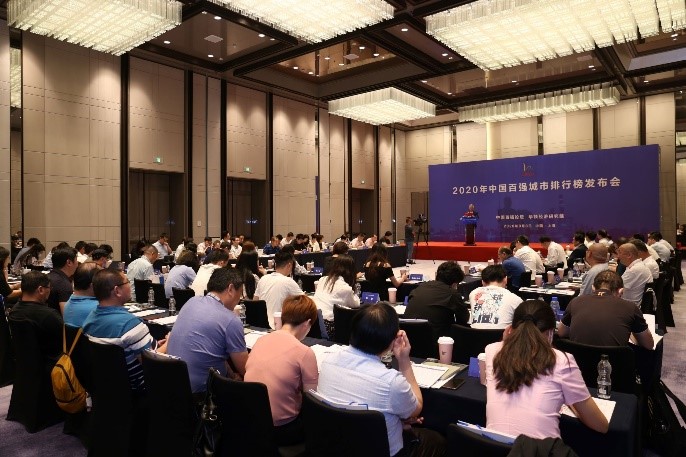
Since 2015, the "CBT 100 Chinese Cities Ranking" has been released for six consecutive years. The list takes the top 110 cities in total GDP as the finalists, and then sorts them according to the comprehensive scores of hard economic indicators (61.8%) and soft economic indicators (38.2%). Hard economic indicators are composed of GDP, household savings and fiscal revenue, and soft economic indicators are composed of environment, science and education, culture, and health. The scores of each indicator are combined according to their total amount (61.8%) and per capita amount (38.2%).
The shortlist is determined according to the total GDP to advocate the continuous expansion of the city, and the per capita volume is considered to advocate the continuous strengthening of the city. Adding soft economic indicators is to advocate the continuous improvement of the city. "Being bigger, stronger and better" reflects the orientation and incentives of "Five Civilization Construction" and "Five Development Concepts", which can more comprehensively and scientifically measure the comprehensive development level of a city in the aspects of economy, society, science and education, culture and ecology.
At the press conference, Duan Xiaoguang, secretary-general of the WEI, made a detailed interpretation of the "2020 China Business Top 100 Cities Ranking":
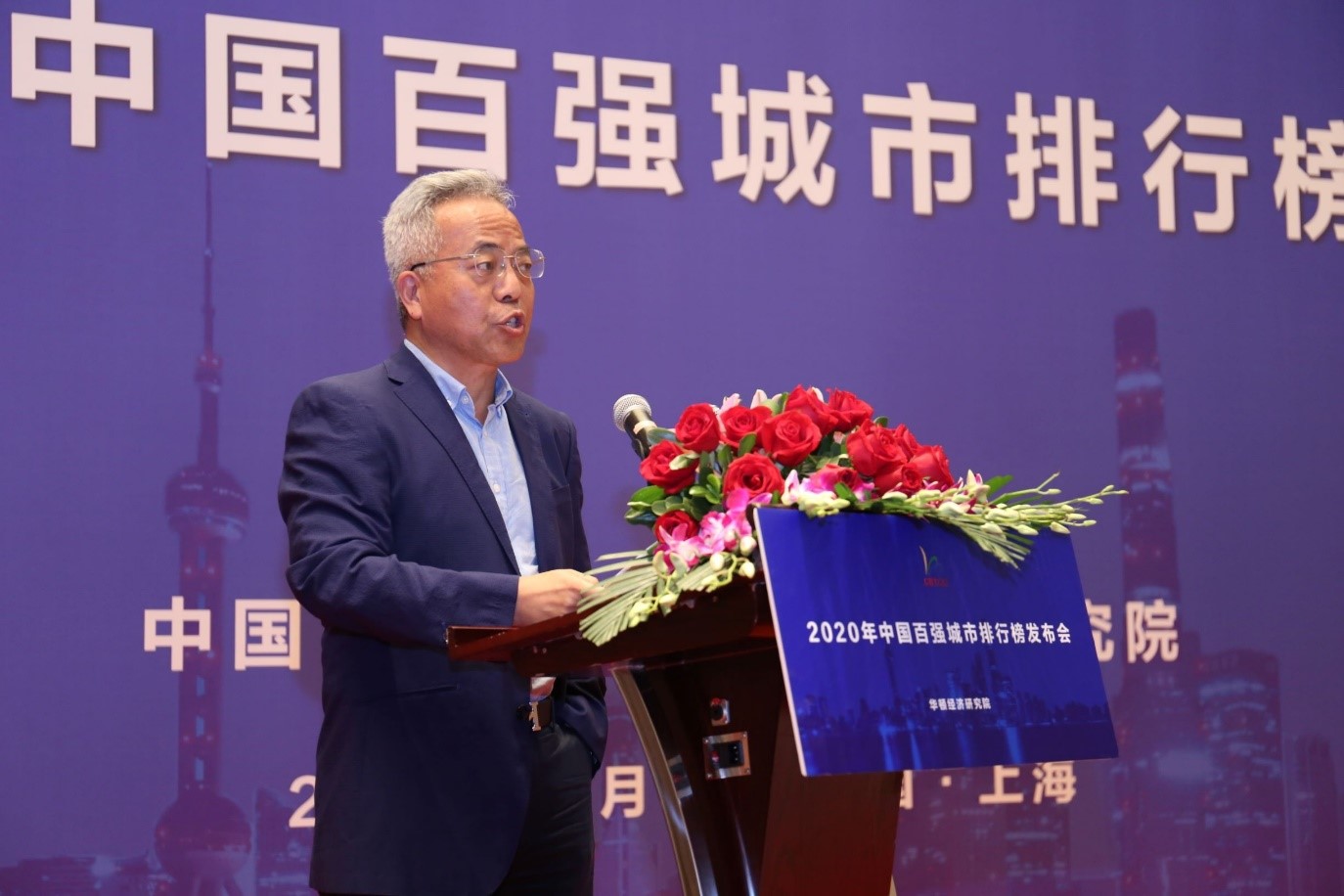
Duan Xiaoguang, Secretary General of the Warton Economic Institute
1. Top 100 cities are the main battlefields of China's economy
In 2019, the total GDP of the country was 99.08 trillion yuan, and the total GDP of the top 100 cities was 69.58 trillion yuan. The total GDP of the top 100 cities this time accounted for 70.23% of the country's total GDP, accounting for 73.87% of the same as last year, and fell by about 3.6 percentage points, but the top 100 cities are still the main battlefields of China's economy. At present, China's economy is under great downward pressure. One of the important reasons is that the hard economy of the top 100 cities has declined significantly. Therefore, improving the economic strength of the top 100 cities in the future is the core force for revitalizing China's economy, especially the cities such as the top ten and top 20 cities, occupy a pivotal position in the national economy in terms of economic strength, and have a strong radiating and driving ability, which will play a leading and decisive role in the future development direction.
2. Top 10 cities: clear hierarchy and fierce competition
In the "2020 China Business Top 100 Cities Ranking", Beijing, Shanghai, Guangzhou and Shenzhen have been in the top four for six consecutive years, with the strongest comprehensive strength. Beijing, Shanghai, Guangzhou and Shenzhen are the top four cities on the list, and there is still a certain gap. Followed by Hangzhou and Suzhou, ranking fifth and sixth, the seventh to tenth cities are Wuhan, Nanjing, Chongqing and Chengdu. Chongqing has returned to the top ten. Wuhan is the only city in the central region that ranks among the top ten, and two cities in the western region, Chongqing and Chengdu, have entered the top ten. From the perspective of the north-south pattern, among the top ten cities, there are 9 cities in the south and only one city in the north, Beijing.
Level 1: Judging from the top ten in the list, Beijing (95.62 points) and Shanghai (90.95 points) have a combined score of more than 90 points, which is obviously the highest or the first level. In terms of hard economy, the economic level of Shanghai and Beijing is not much different, but Beijing, as the capital city, has obvious resource advantages and strong soft economy, especially in terms of environment, science, education and health, which are significantly higher than Shanghai.
The second level: Guangzhou (78.59) and Shenzhen (77.23), in terms of comprehensive scores, the difference between the two scores is relatively small, belonging to the same level of cities, but there is still a gap of as much as 12 points with Beijing and Shanghai. Shenzhen's economic strength is higher than that of Guangzhou, but it is far behind Guangzhou in terms of soft economic strength, especially in science, education and medical care. Shenzhen ranks 20th in the level of soft economy and the lowest among the top ten cities, which does not match its status as the "third city" of economy.
The third level: Hangzhou (73.14 points) and Suzhou (71.07 points) ranked fifth and sixth with a combined score of around 72 points. Suzhou's economic strength is higher than that of Hangzhou, and it is the "fifth city" of the economy. As the capital city of Zhejiang, Hangzhou has relatively rich and perfect scientific, educational, cultural and medical resources. Therefore, the level of Hangzhou's soft economy is higher than that of Suzhou. Suzhou's soft economy does not match its economic status.
The fourth level: the other cities with a score of about 70, covering the seventh to tenth cities, are Wuhan (70.60), Nanjing (69.93), Chongqing (68.52) and Chengdu (68.25), the four cities scored evenly and the competition was fierce.
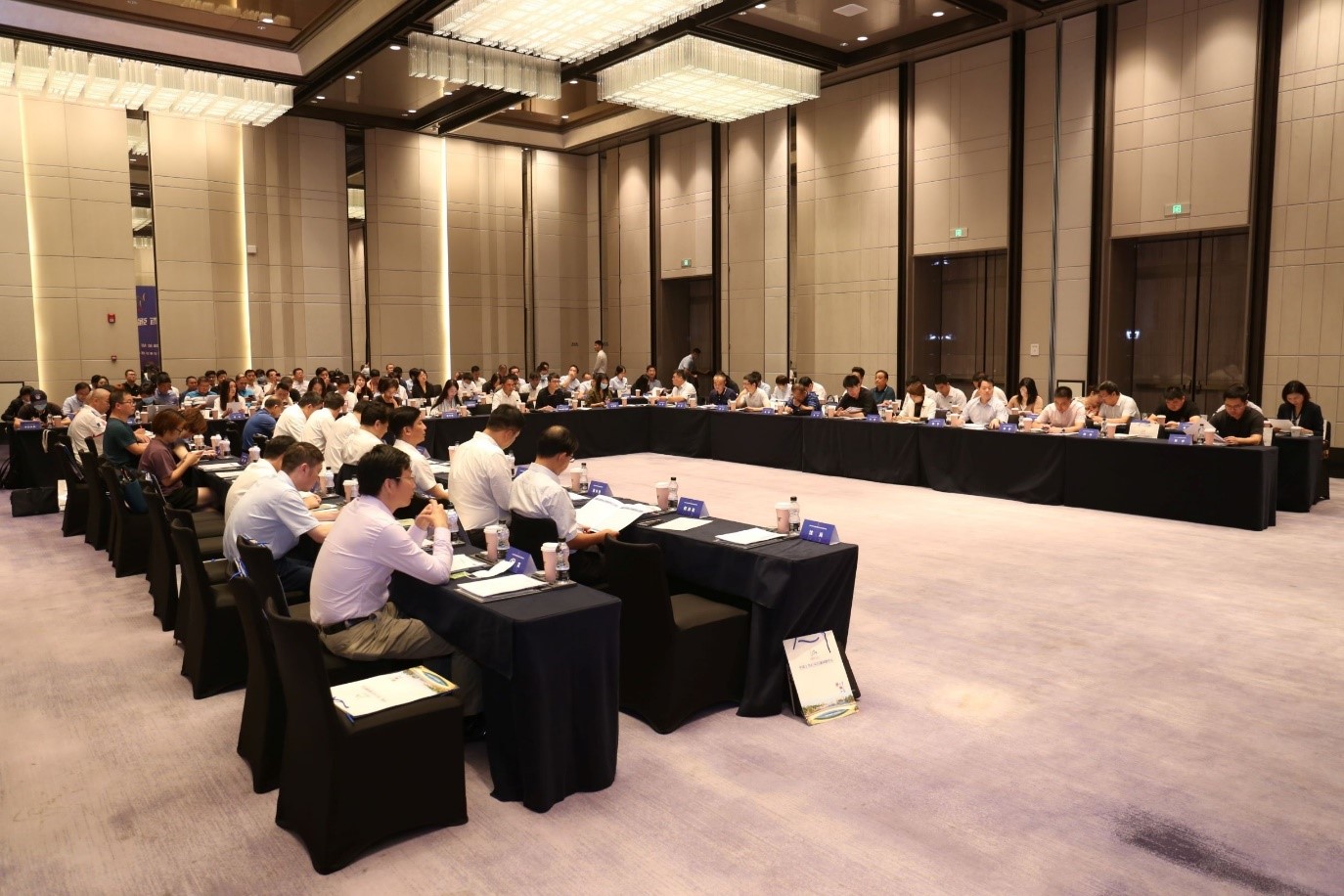
3. The soft and hard economy should develop in harmony
Eight of the top ten cities have relatively balanced soft and hard economic development, and nine of the top ten are cities at or above the sub-provincial level, so the allocation of soft economic resources such as science, education, culture, and health is abundant. In the top 100 list, there are still a large number of cities whose strengths in the hard economy and soft economy are not balanced, and there is a big difference.
Shenzhen and Suzhou ranked 3rd and 5th in the hard economy, and ranked 20th and 18th respectively in the soft economy. Shenzhen needs to further improve the number of ordinary colleges and universities, and also the number of full-time teachers and the number of hospitals. Suzhou's hard economy is the fifth city, and its soft economy ranks 18th; Wuxi's hard economy ranks 10th, and its soft economy ranks 23rd. Therefore, Suzhou and Wuxi need to strengthen the soft economy while developing their economies. Collaborative development, especially in the fields of science, education and health. As the provincial capital, Xi'an ranks 7th in soft economy and 22nd in hard economy. Therefore, Xi'an needs to strengthen the development of hard economy.
In the CBT 100 list, Ordos, Yulin, Taizhou, Ningbo, Harbin and Ganzhou also have a big difference in the soft and hard economic rankings. Ordos, Yulin, and Taizhou are all in the top 50 in the top 100 list in terms of hard economy scores, while their soft economies are all below 90. Among them, Yulin needs to be further improved in terms of environment, and Ordos and Taizhou still need to improve its science, education and sanitation. Ningbo ranks 9th in the national hard economy and 34th in the soft economy. Its overall ranking has fallen due to the backwardness of the soft economy score.
Harbin and Ganzhou have outstanding performance in terms of soft economy. Among them, Harbin ranks the highest in soft economy, ranking 14th. However, due to the decline in GDP and fiscal scores, the ranking of hard economy and soft economy is unbalanced. Harbin needs to vigorously develop hard economy. The comprehensive ranking of Ganzhou has risen for three consecutive years, but the gap between the soft economy and the hard economy of Ganzhou is relatively large. In the future, while strengthening the construction of comprehensive urban civilization, Ganzhou can rationally plan and layout the industrial structure, find new kinetic energy to drive local economic growth, and improve economic strength, and achieve a comprehensive and coordinated high-quality development blueprint.
4. Regional distribution: distributed in steps from east to west
There are 60 cities in the eastern region, 25 in the central region, and 15 in the western region, showing a pattern of descending from east to west. The top 100 cities in the three major economic circles are highly concentrated, with 25 cities in the Yangtze River Delta region, 8 in the Pearl River Delta region, and 8 in the Beijing-Tianjin-Hebei region, for a total of 41 cities in the three regions. What is particularly striking is that four cities in the Yangtze River Delta, Shanghai, Hangzhou, Suzhou and Nanjing, are in the top ten, two cities in the Pearl River Delta are in the top ten, and only one city in the Beijing-Tianjin-Hebei region is in the top ten. It can be seen that the Yangtze River Delta is the most influential and economically developed region in China, and has made great contributions to the national economic growth.
5. Jiangsu, Shandong, Zhejiang and Guangdong lead the way, and Fujian, Jiangxi and Anhui have made significant progress
Divided by province, Jiangsu, Shandong, Zhejiang and Guangdong ranked the top four in terms of the number of cities on the list. Among them, Jiangsu has 13 cities on the list; Shandong has 12 cities, ranking second; Guangdong (9) and Zhejiang (8) ranked third and fourth. This year, Jiangsu Province performed outstandingly, with Suzhou and Nanjing ranking among the top ten. It should be pointed out that Jiangsu has the most balanced development. All 13 prefecture-level cities are on the list, and it is the only province in the country where all prefecture-level cities are on the list. Wuxi performed well in terms of economy, rising to the 12th overall ranking, and its hard economy, total GDP and per capita GDP ranked in the top ten in the list respectively. The 8 cities in Zhejiang are generally ranked high, and the comprehensive rankings of the cities on the list are all in the top 55 camps.
Fujian Province performed well, with Fuzhou, Xiamen, Quanzhou, and Zhangzhou all rising from last year, and three new top ranks among 100 cities, namely Longyan, Putian and Sanming. In addition, although there are not many cities in Anhui and Jiangxi on the list, they have made significant progress. The two cities in Anhui, Hefei and Wuhu, have risen significantly in the rankings, and a new city, Chuzhou (No. 90), has entered the top 100; Jiangxi Province not only has new cities on the list for three consecutive years, but all the cities on the list have improved their rankings, indicating that Jiangxi's comprehensive strength has been continuously enhanced. This year's new city in Jiangxi is Yichun, ranking 99th, and the city on the list last year was Jiujiang, which ranked 74th this year.
Henan in the central region has the most cities on the list, with 6 cities in the top 100; followed by Hunan, with 5 cities on the list, Jiangxi and Anhui with 4 and 3 cities respectively.
Among the 15 cities in the western region, there are 5 provincial capitals (Chengdu, Xi'an, Kunming, Guiyang, Lanzhou), 1 municipality directly under the Central Government (Chongqing), 3 autonomous region capitals (Urumqi, Nanning, Hohhot), and the remaining 6 are Prefecture-level cities indicate that the western region is dominated by a single central city, resulting in a large regional economic disparity within the province.
At the meeting, the WEI also released a list of the top ten cities in five categories, including hard economy, soft economy, household savings, fiscal revenue, and per capita GDP.
The list of the five major projects in 2020
1. Top 10 cities with the highest hard economic scores
Beijing (95.82), Shanghai (95.57), Shenzhen (88.28), Guangzhou (78.50), Suzhou (77.41), Hangzhou (73.63), Nanjing (70.42), Wuhan (69.30), Ningbo (68.25), Wuxi (67.99)
2. Top 10 cities with the highest soft economy scores
Beijing (95.29), Shanghai (83.48), Guangzhou (78.74), Wuhan (72.70), Hangzhou (72.34), Chongqing (70.78), Xi'an (70.60), Chengdu (69.97), Nanjing (69.13), Changsha (68.30)
3. Top 10 cities with the highest household savings scores
Beijing (100.00), Shanghai (93.06), Guangzhou (80.90), Shenzhen (79.06), Hangzhou (72.81), Chengdu (72.78), Chongqing (68.76), Tianjin (68.34), Suzhou (68.04), Ningbo (66.37)
4. Top 10 cities with the highest fiscal revenue scores
Shanghai (100.00), Beijing (95.77), Shenzhen (89.90), Suzhou (78.07), Tianjin (75.41), Hangzhou (75.14), Ningbo (74.01), Nanjing (71.65), Wuhan (67.72), Wuxi (66.80)
5. Top 10 cities with the highest GDP per capita
Shenzhen (203,000 yuan), Wuxi (180,000 yuan), Suzhou (179,000 yuan), Zhuhai (176,000 yuan), Ordos (173,000 yuan), Nanjing (166,000 yuan), Beijing (164,000 yuan), Shanghai (157,000 yuan), Guangzhou (156,400 yuan), Changzhou (156,300 yuan)
Combining the characteristics of the top 100 cities and the trend of future economic development, Secretary-General Duan Xiaoguang also put forward two suggestions for urban development:
1. Focus on the science, education, culture and health industry, create domestic demand and revitalize the economy
The soft economy is mainly reflected in industries or undertakings such as science, education, culture and health, especially high-end education, high-quality culture, and high-quality medical care. The current market structure is that private economic goods are in a state of excess, and science, education, culture and health are public goods, and now they are in short supply, which is a weak economy. The role of the government must be brought into play to solve supply-side reforms in science, education, culture and health with new methods to meet the huge and urgent needs of the people, so as to revitalize and upgrade the economic structure. The demand for high-quality hospitals, education and cultural undertakings is huge. Through the development of these industries, the creation of domestic demand will drive a series of economic development of private goods. First, the development of hospitals and scientific research institutes will drive the development of a series of infrastructures, which will then drive the development of the manufacturing industry in the private goods economy such as medical equipment, scientific research equipment, educational equipment, cultural and entertainment equipment, etc. ; which finally drives the employment growth of doctors, teachers, cultural and scientific researchers through the improvement of the employment structure, thereby driving the industrial development and the comprehensive transformation and upgrading of the economic and social structure.
2. Multi-center leads the comprehensive and coordinated development of "Three Circles and One Belt"
The Yangtze River Delta, Pearl River Delta and Beijing-Tianjin-Hebei are the three major economic circles in China. There are 8 out of top 100 cities in the Pearl River Delta, including 2 top ten cities, Guangzhou and Shenzhen; 25 out of top 100 cities are in the Yangtze River Delta, including Shanghai, Hangzhou, Nanjing and Suzhou which the 4 cities are in the top ten cities; Beijing-Tianjin-Hebei has 8 cities in the top 100, of which Beijing is one of the top ten cities. Comparatively speaking, the Yangtze River Delta is the "new force" of China's economy, and it is also the region with the most balanced economic development in China. There are a total of 41 out of top 100 cities in the "Three Circles", of which the Pearl River Delta is highly developed, and the Pearl River Delta region has formed a multi-center urban development. The economic circle led by the three core cities (Shenzhen, Guangzhou and Hong Kong) will achieve win-win industrial cooperation in the region, and vigorously enhance the overall competitiveness of the Pearl River Delta Urban Agglomeration by adjusting industrial layout, optimizing industrial structure, promoting regional coordinated development. But it is worth noting that, except for Zhanjiang, there are still 12 prefecture-level cities in Guangdong Province that have not entered the top 100. It can be seen that the development of Guangdong is extremely unbalanced, and the comprehensive and coordinated development of Guangdong's overall economy is a major task for Guangdong Province and the Pearl River Delta. Only Beijing has outstanding strength in the Beijing-Tianjin-Hebei region. Tianjin's development has been weak in recent years. This year, it has fallen out of the top ten. Six of the 11 prefecture-level cities in Hebei have entered the top 100. Therefore, the development of Beijing-Tianjin-Hebei also requires comprehensive and coordinated development. The first method is to revitalize Tianjin's economic development in an all-round way, and at the same time to accelerate the construction of the Xiong'an New Area, build a multi-center development pattern of Beijing, Xiong'an and Tianjin, which can drive the comprehensive and coordinated development of "Beijing-Tianjin-Hebei" and the northern China. Therefore, through the multi-center development of the "three circles", the comprehensive and coordinated development of China's economy will be driven.
The Yangtze River Economic Belt is the "main force" of China's top 100 cities, with coordinated development of economy, culture, science, education, health and environment. Shanghai, Hangzhou, Nanjing and Suzhou lead the balanced development of the middle and lower reaches of the Yangtze River; Wuhan, Chengdu and Chongqing lead the middle and upper reaches of the Yangtze River. The development of the Yangtze River basin can drive the coordinated development of the East, central and western regions. The Yangtze River Delta urban agglomeration in the lower reaches of the Yangtze River, the Wuhan urban agglomeration in the middle reaches of the Yangtze River, and the Chengdu-Chongqing urban agglomeration need to give full play to the radiation and leading role of the central cities to create the three growth poles of the Yangtze River Economic Belt.
The Yangtze River Delta urban agglomeration has an extremely important position and role in the "Three Circles and One Belt", which can not only drive the coordinated development of the East, the Middle and the West, but also radiate the economic growth of the North and the South. It needs special attention that how to develop the Yangtze River Delta in the future. Shanghai is now the largest single economic city in China, it also faces similar congestion and pollution problems as Beijing; therefore, it is necessary to learn and learn from the model of "Beijing + Xiong'an New Area". More than 100 kilometers away, a regional center will be built in necessary to jointly lead the development of the Yangtze River Delta. The three cities of Suzhou, Wuxi and Changzhou are closely linked together, and the total GDP has exceeded that of Shanghai. The per capita GDP of Suzhou and Wuxi also greatly exceeds that of Shanghai. Therefore, "Shanghai + Suxichang" can become the dual core of the Yangtze River Delta, which together constitute the core area of the Yangtze River Delta; meanwhile, together with the four sub-centers "Nanjing, Hangzhou, Hefei and Ningbo" jointly drive the coordinated development of the entire Yangtze River Basin and the national economy.
The development of urban agglomeration will bring new development opportunities, and the multi-center urban development pattern of "three circles and one belt" can drive the comprehensive and coordinated development of the national economy.
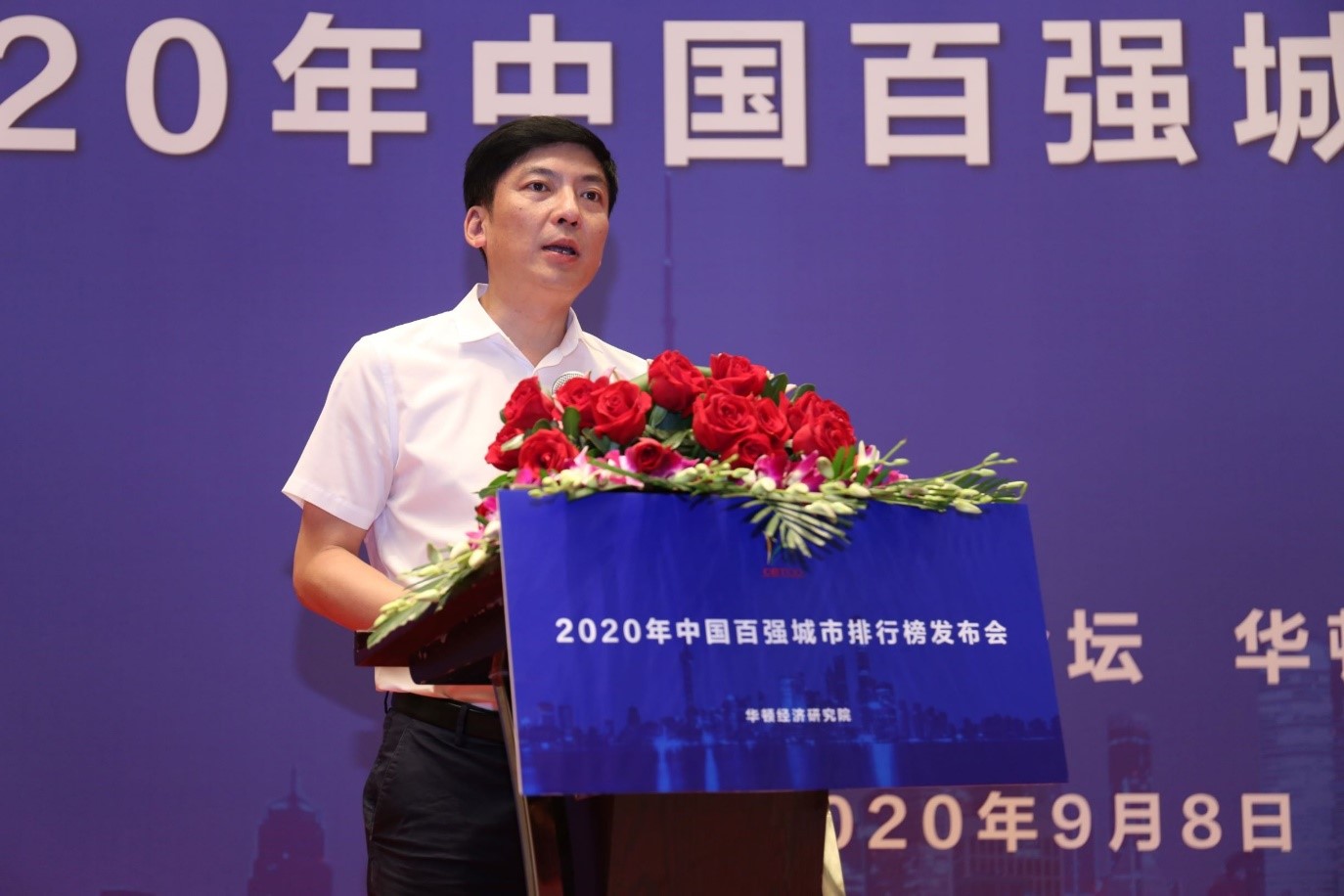
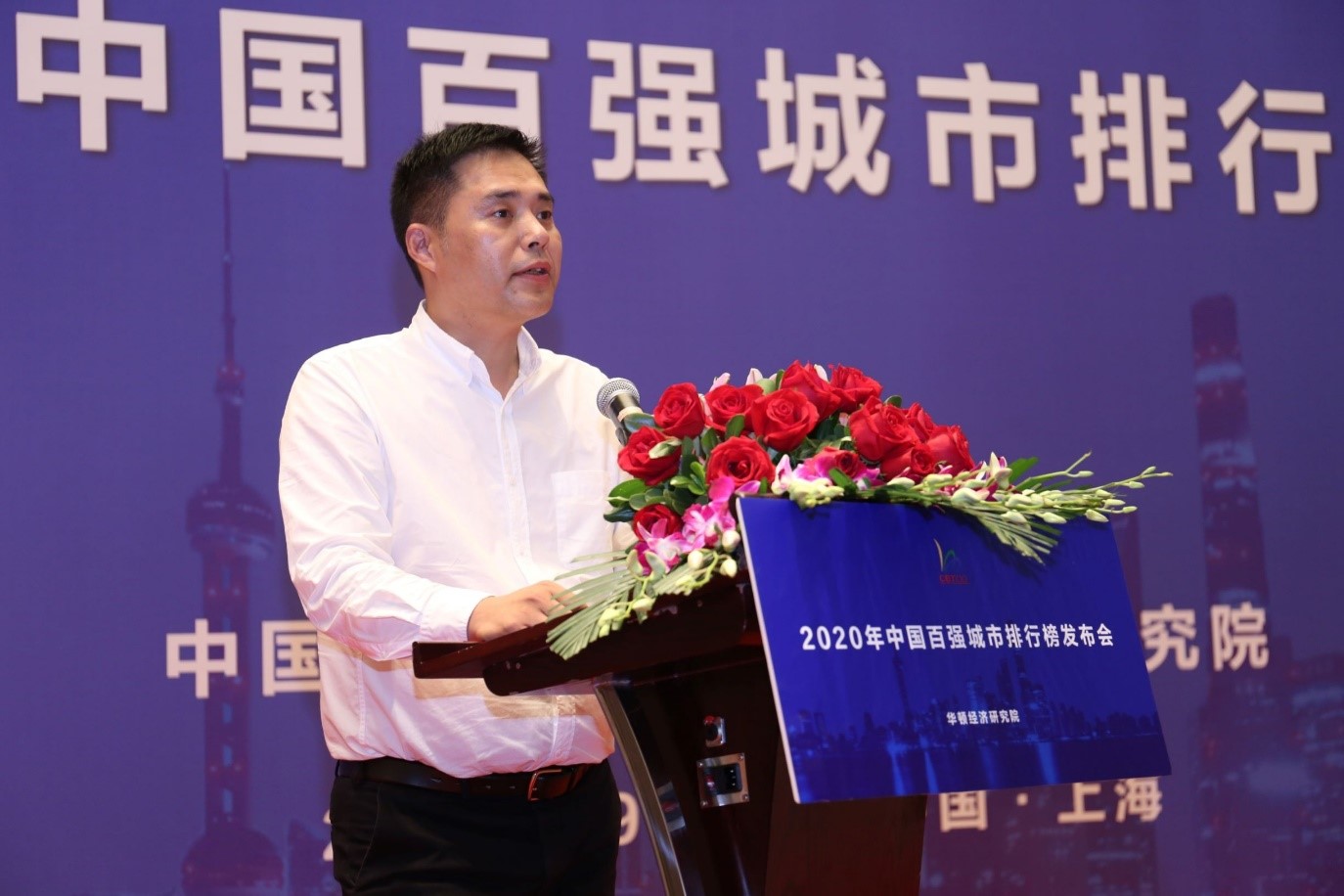
At the press conference, Lu Wei, member of the Standing Committee of the Shaoxing Municipal Party Committee and Secretary-General, as the representative of the top 100 cities, and Chen Xingjie, deputy secretary-general of the Chuzhou Municipal Government, as the representative of the new top 100 cities, introduced their recent experience in high-quality economic and social development.
Finally, Secretary-General Duan Xiaoguang also announced that the 2020 China Business Top 100 Cities Comprehensive Development Forum will be jointly held again with the 20th China Business Top 100 Listed Companies Summit Forum from November 27th to 28th. The theme of this year's forum will be "deepening capital market reform and comprehensively revitalizing China's economy". At the same time, it will issue an initiative to create a beautiful city, comprehensively enhance the value of the city, and realize the coordinated development of soft and hard economies in the top 100 cities.